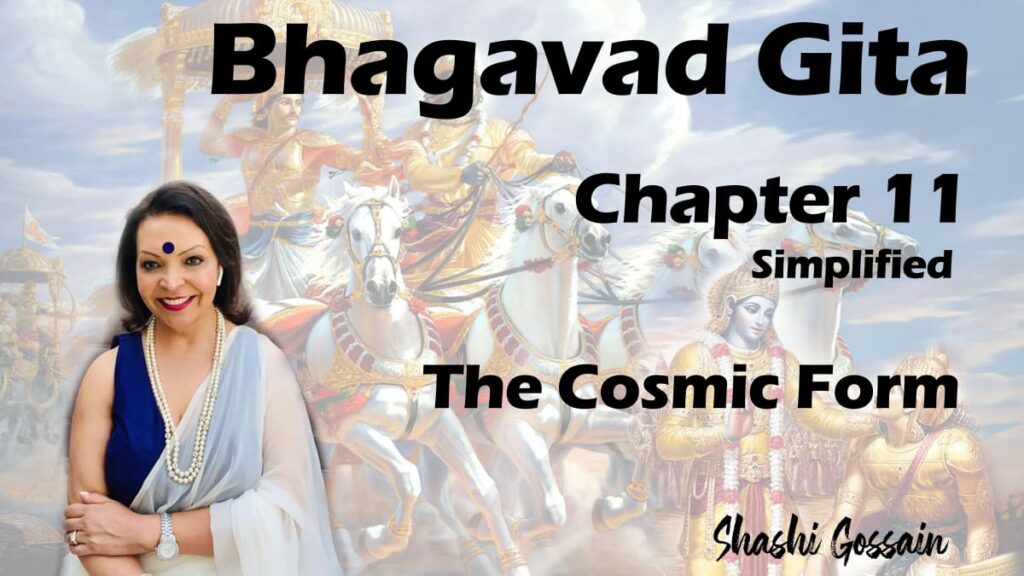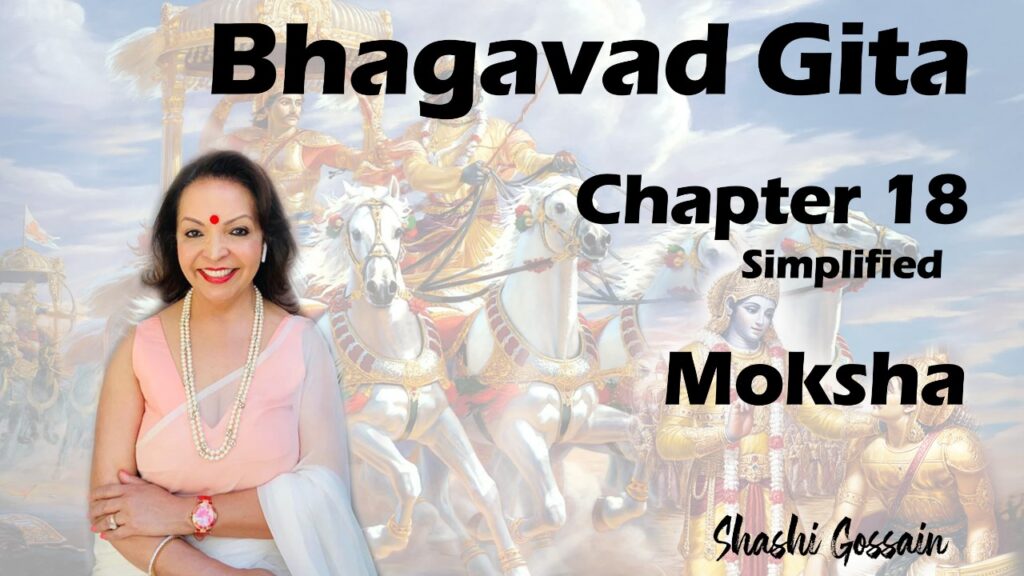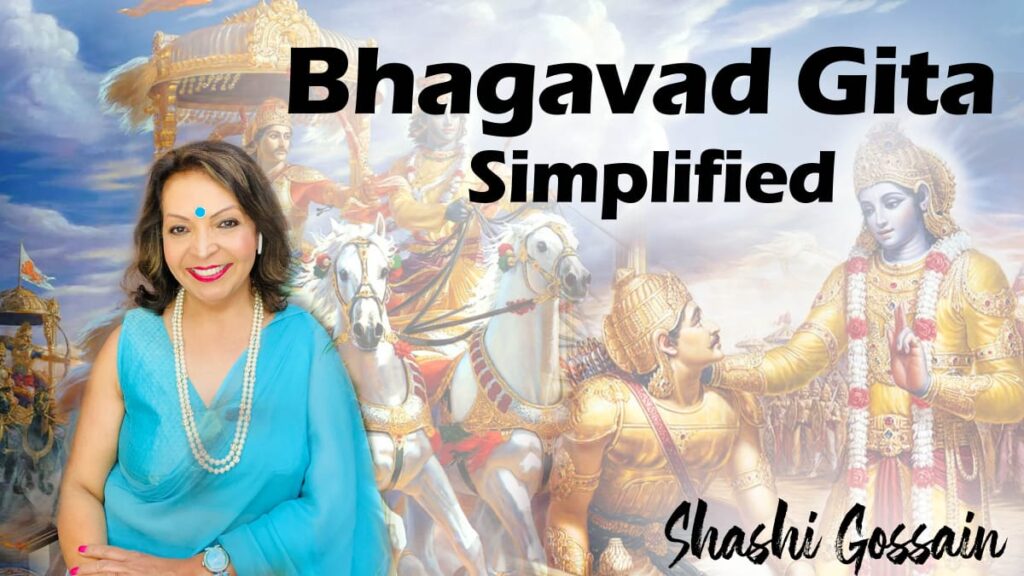What did Arjuna see in Krishna’s universal form?
Arjuna wants to see Krishna (Ishvara) as the entire Universe. We begin the eleventh chapter with Arjuna’s words. Arjuna recalls the root cause of his panic attack from the first chapter which is moha or delusion which caused confusion between his duty as a warrior and as a family member. He now says that his delusion has been dispelled because Shri Krishna had revealed the knowledge of the self, or the meaning of “I” or “adhyaatma vidyaa” to him. When Arjuna understood his true nature as the self, the aatmaa, the eternal essence, he came to know that the self does not kill or be killed. It is not responsible for the actions or the results. He then realized that even if his body died, or his body killed another body, nothing would happen to the eternal essence in any of those bodies. He acknowledges that he has understood the supreme secret knowledge, which asserts Ishvara as the creator, maintainer and dissolution of the entire universe. In other words, there is no other cause of the universe besides Ishvara. He is both the raw material and the intelligence behind the universe. Having heard the indestructible glory of Krishna, Arjun wanted to see:
- The Lord’s Supreme Divine form.
- How everything originated, existed and dissolved within Ishvara.
- How everything was Ishvara in essence.
He wants to see how it all comes together as one undivided entity. Shri Krishna immediately agreed to show Ishvara’s divine form in thousands of shapes & colours. This entire chapter, written in a poetic style, elaborately describes this form and Arjuna’s reaction to it. It is said that the chanting of this chapter is one of the highest forms of meditation possible. He now shows in his form:
- Deities and the demi-gods
- Twelve Aadityaas
- Eight Vasus
- Eleven Rudraas
- Two Ashvini Kumars
- Forty-nine Maruts.
Arjuna could now see the deities he had heard about, with those own eyes. Shri Krishna tells Arjun that only he can see theses sights. Krishnaji realized that Arjun’s mortal eyes could not view the cosmic form. Shri Krishna through the Divine Yoga Power blessed Arjuna with the “divya drishti”, the divine vision through which he can show Arjuna the entire universe in one place, without leaving his chariot. He is also able to show events that had taken millions of years in a split second, including entities that move, and entities that are stable. Metaphorically speaking, with our normal sight, we can only see finite objects in front of us. Once we open up our vision & mental state, we can see the vastness of the universe in front of us. Krishnaji shows his vast cosmic form, with infinite number of faces & eyes to Arjuna, who was overwhelmed. On one side he saw Shri Krishna decked with jewellery & on the other, with weapons, for destruction. The cosmic form had infinite heads, of all the deities, powers, weapons, nature. All the diversities, serving one Ishvara, just like we have millions of cells, tissues & organs in our body serving one person. Our minds are used to dividing things, cutting up things to give shape or form. The cosmic form is meant to reverse that process and unify everything. Sanjaya, describes to Dhritrashtara the level of cosmic’s brightness, as radiance emitted by an infinite number of suns rising at the same time. Now that his vision became a little clearer, Arjun saw the entire universe with the earth, the sky, the oceans, animals, plants, trees and humans as just one tiny piece of that vast cosmic form. When Arjun saw Ishvara’s cosmic form, he realized that the universe is nothing but a small fraction of Ishvara’s creation. He realised his problems, challenges & worries were miniscule in relation to the cosmic. Arjun was awe-struck and humbled, as he realised that he was nothing compared to the glory of the infinite Ishvara. Arjun says that he sees all kinds of-
- Deities, including Lord Brahma, who live in heavens
- Divine sages e.g. Vasishta, who live on earth
- Divine serpents e.g. Vasuki, who live below earth
All situated on Ishvara’s cosmic form. Arjuna realizes that he is seeing worlds that are beyond the earth and beyond the human capacity of vision. So Arjuna, in the cosmic form, saw the creator and his creation. Arjun, being an army commander, was used to see gigantic military & clear formations but he was totally baffled as he was completely engulfed and surrounded by this cosmic form in all three dimensions, with no beginning, middle or end. Shri Krishna reveals the limitations of the mind with its tendency to chop up everything into fragments. It fails to understand Ishvara’s mind which is operating at the cosmic level. Arjun could not comprehend the whole experience.
Arjun saw Lord Vishnu’s:
- Mace: symbolize spiritualism discipline
- Discus: symbolize destructive power of time
- Conch: symbolizes a call to action
- Crown: symbolises Ishvara, as the ultimate commander
“The blazing fire of sunlight”: light of the eternal essence Arjun praises Ishvara’s cosmic form. He understood the relationship between Ishvara and the eternal essence. Ishvara is the foundation which creates, sustains and dissolves this universe of names and forms. It is similar to the relationship of waves and ocean. It’s all water, but is:
- Indivisible
- Eternal
- Infinite
- Imperishable
Arjuna can see the moon & sun and calls them the eyes of the cosmic form. Next, Arjuna describes Ishvara’s powerful “prana shakti”, through infinite arms: powers the universe with infinite prowess to perform infinite actions. Our minds are conditioned to believe that Ishvara is sitting somewhere far away. He is separated from us by space, or distance. But when Arjuna saw the cosmic form, he realized that space and time is not different from Ishvara. However, Ishvara can also have a frightful form, which is feared by all three worlds. The next shloka highlights people with regards to their spiritual awareness.
- The ignorant: completely engrossed in the material world of names and forms, with no awareness of the unity of things, or the presence of Ishvara in everything.
- The seekers: who have recognized the presence Ishvara, and are working hard to turn themselves towards the higher.
- The enlightened: who have realised the Absolute. Arjun saw all three types of people, dissolving into Ishvara, but only the seekers were singing praises of Ishvara since they knew that he was their ultimate goal. Arjuna was clearly delighted to see those deities that were only invoked and worshipped in rituals. It is said that the universe split into 3 parts during the process of creation.
- “adhyaatma”:The individual
- “adhibhoota” : Objects
- “adhidaiva”: the Deity that connects the two
So if we are praying for a particular trait, we have to pray to a certain deity, e.g.: if we require strength, we pray to Lord Hanuman; if we seek knowledge, we pray to Goddess Sarasvati. When we meditate, we can choose any deity, as long as we use the deity to ultimately take our meditation to Ishvara. In order to show cosmic in all its forms, Shri Krishna’s face turned from a kind & smiling one, to a fearsome, monstrous one. Ishvara comprises the entire creation where everything is necessary and everything has its place. Good & Bad. We have to get rid of conceptions of dualities in order to understand Ishvara. Arjun now admits he’s terrified of the enormity of the cosmos, especially when it is in the form of destruction. In the second chapter, Shri Krishna mentioned that a “sthita-prajnya” or one who is established in the eternal essence has three key qualities:
- holistic vision
- serenity of mind
- unattached living
Arjun, who is normally serene, now gets destabilised. This shloka reminds us to recognize Ishvara’s handiwork behind every situation & never to lose faith in him, but that every unfortunate circumstance is a means for our self-purification. With so much fear in him, Arjun realises it’s the end point. When we realize that ultimately, we are powerless in front of the grand scheme of the cosmos, our ego drops and surrenders itself in prayer to Ishvara. Prayer is only possible when there is utter surrender of individuality. Shree Krishna now showed Arjuna the future. Arjuna saw the future state of Mahabharata war & all the characters. He sees all the sons of Dhritrashtram Bhisham, Drona, Karna rushing into Ishvara’s mouth, like a moth is attracted to a flame, only to perish. So this is an example of Ishvara, who creates, and then dissolves all beings. Every individual creates his own destiny; so inevitably, many warriors would die & move on, according to their karmas. By showing the process of destruction at such a grand scale, Shri Krishna also wants to remove Arjuna’s fear of death. Arjuna now understood that there’s nothing to be scared about destruction. It was a crucial part of Ishvara’s creative process. There is no question of pain once we die, as the body perishes. We are scared not about the pain of death, but about losing our identity and network of relationships. But when we know that death is nothing but a return of our name to Ishvara’s, our fear of death will diminish to a great extent. Destruction is a necessary part of life. If old trees and animals do not die in a jungle, new ones cannot be created. If no one dies, the earth is unable to sustain the needs of an infinitely growing population.
What Lord Krishna told to Arjuna?
Arjuna asked Shri Krishna, “What was his purpose for destroying everything?” And Shri Krishna in his cosmic form, replied:,
“I am “kaala”, which means time. Time & death mean the same thing, because with time, death occurs. So Krishnaji showed him the future, with the Mahabharat war ended, leaving a few kshatriya warriors alive. In other words, Shri Krishna himself had determined that the war would be won by the Paandavas. They fought like any other army would, but the real work behind the scenes was done by Shri Krishna. Meaning Krishna is running the whole show on earth, called his “leela”. Shri Krishna had pre-planned the ending of the war, and had orchestrated the events in such a manner that it would result in the destruction of the Kauravaas. Shri Krishna encouraged him to fight with all his might, defeat his enemies and enjoy the result of his actions. Arjuna was only an instrument. Defeat & Death ere inevitable. At this point, Arjuna is totally disturbed. He had seen so many aspects of Ishvara in a space of a few minutes.
- Pleasant cosmic form, (“soumya roopa”), then
- Fearful cosmic form,(“raudra roopa”) then
- The destructive power, (maaya) and
- The knowledge that every action was determined by Ishvara.
Shri Krishna recognized his mental state. He gave clear, simple and precise instructions to Arjuna : do not worry, just fight. All these mighty warriors have already been killed by me.
You kill them:
- not because of enmity
- for performing your duty as a karma yogi
You are just an instrument of Ishvara. Meanwhile, Sanjaya had relayed all this to Dhritraashtra & was hoping he would end the war, when he knew his sons will be killed. But Dhritraashtra was so attached to the kingdom, with his sons as rulers, that he ignored Sanjaya’s plea. We shall become more content when we understand & accept that Ishvara is behind each event for the benefit of the entire universe. Arjuna’s image of Ishvara now becomes clearer. He acknowledges Ishvara’s:
- “aadideva”: creative power, who created Brahmaa, the creator
- “anantaroopam” creator of an infinite number of forms
- “vishwam”, creator of the magnificent universe.
- “tatam”: pervades the entire universe.
- “parama dhaama”: the supreme abode, where everything resides after dissolution
- “Vayu”: the lord of wind who sustains all living beings.
- “Yama”: the lord of death who ensures justice for everyone.
- “Agni”: the lord of fire who provides energy to all beings.
- “Varuna” : the lord of water, for sustenance
- “Shashaanka”: the moon, who nourishes all plants and herbs.
- “Prajaapati”: also known as Lord Brahmaa, creator of the universe
- “Prapitaamaha”: the great-grandfather, who brought all the deities into existence.
Arjuna had always prided himself to be a great warrior & archer, but when he found that it was Ishvara behind all his actions, and the ultimate source and cause of everything he completely surrendered his pride and bowed. As by now his mind was spinning, he didn’t know which direction the cosmic form was, so he offered salutations from all sides. This is called “vandanam”. The sheer act of bowing gets rid of our “ahankaara” or ego. Arjuna and Shri Krishna were childhood friends & had grown up together. But Arjuna never realized the divine nature of Shri Krishna. He had treated him as he would treat any other friend of his. Arjuna now realised that he had often ill-treated & insulted Krishnaji, purely due to ignorance & jest. Arjuna wanted to ask for forgiveness from Krishnaji for his past behaviour. Arjuna addresses Shri Krishna as the
- Father of the Universe. He is the ideal parent:
- provides physical and emotional support to their children
- greatest guru, or teacher, for their children
- teaches the right knowledge and values
- Lord of the three worlds.
- Heaven, hell and earth.
- Physical state: Awake, dream-state or deep sleep
Arjuna then totally surrenders and prostrates himself to Ishvara by doing “saashtaanga namaskaara”.
He asks for:
- a father’s forgiveness
- a friend’s forgiveness and
- a beloved’s forgiveness
However, Arjun says that although he is over-joyed at seeing his divine form, he is fearful. Arjun begs Shri Krishna to transform back into his normal, loveable form.
- The embodiment of peace and serenity.
- The form that was the object of their meditation.
Shree Krishna replied that he had only shown his forms to illustrate his power or maaya. It was to illustrate the creation and destruction with equanimity in our lives.
How can I live a fruitful life?
Shri Krishna wants us to view the same Ishvara in all aspects of life: pleasant and unpleasant. Shri Krishna goes on to say, that you cannot get liberation by:
- Studying the Vedas : teaches us to lead an ethical life
- Performing sacrificial rituals: which is a form of renunciation
- Charity: which reduces ego
- Severe penance: which strengthens us mentally & physically?
These are tools to-
- lead a fruitful life and
- means to purify our mind
But it has not yet received the knowledge about the eternal essence. Krishnaji asked Arjuna not to worry & remove all traces of fear. He assured him that he was the same person, his friend & companion, and not some other person. This is a metaphor to Arjuna & applicable to us, to go about our lives with a fearless attitude, because he is present in everything. After this, Sanjaya takes up the commentary again, and tells Dhrishtra that Krishnaji assumed his normal self, as a charioteer with reins in his two arms. Arjuna becomes calm again, free from fear & bewilderment of the images he had just witnessed. Arjuna addresses Krishnaji as “Janardana” which is made of 2 words: “Jana”: means people and “arda”: means one who moves. So Shri Krishna is referred to as “one who moves people to heaven or hell”, or “dispenses justice according to Karma. Krishnaji tells Arjuna that he has only revealed his true scope to him and not even to the Deities. Only single-minded devotion or “ananya bhakti”, will lead to Ishvara, which is:
- Constant devotion without expecting materialistic rewards &
- Feel our essence united with the universe.
How one can attain God’s Kingdom?
Shri Krishna says that Ishvara can be attained by following five principles:
- devote all actions to Ishvara (karma yoga)
- focus on Ishvara as the ultimate goal (jnyaana yoga)
- observe single-minded devotion to Ishvara (bhakti yoga)
- remain free from worldly attachments
- do not harbour likes or dislikes
All traits are connected & strengthen each other, where the individual essence sees itself as part of the universal eternal essence. To recap, Arjuna appreciates the teaching and sees the universe as the Lord himself. Shree Krishna had removed the concept of time and space in order for Arjuna to see the cosmic form. He could see the birth and destruction of fellow warriors. He could see all the deities, universe & nature all at once.




Pingback: Bhagavad Gita Chapter 12: The Devotion - Simple Hinduism